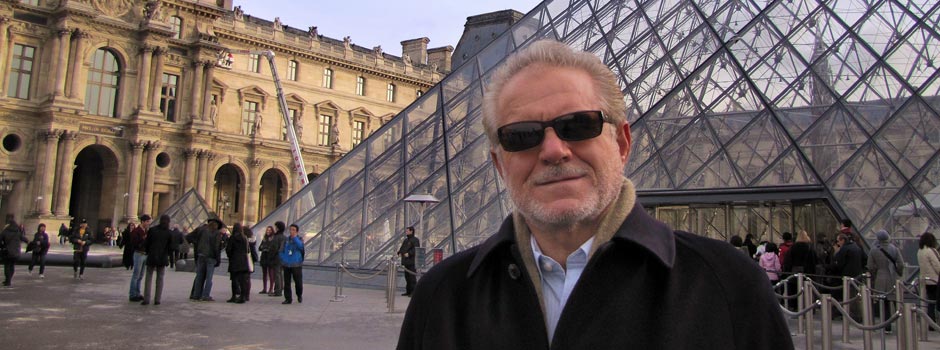
An Interview with Dr. Nazeih Taleb Maarouf, Head of the Crafts Development Program, IRCICA Contemporary Islamic Crafts
Feb 26, 2013 Interview

Dr. Nazeih Taleb Maarouf is the Head of the Crafts Development Program at the International Research Center on Islamic Culture and Art (IRCICA) in Istanbul. He has dedicated his working life to the preservation of the Islamic traditional arts and crafts. Dr. Maarouf appreciates the diversity and perennial beauty of Islamic handicrafts as well as the fresh approach modern day craftsmen and craftswomen bring to traditional art forms. Moreover, he believes that Muslim countries would greatly benefit economically from better supporting the handicrafts sector and his work with many OIC countries proves him right. Many of us understand the importance of supporting the Islamic traditional arts. But who knew the complex policies and important economic implications underwriting the numerous crafts markets and products found across the Muslim world?
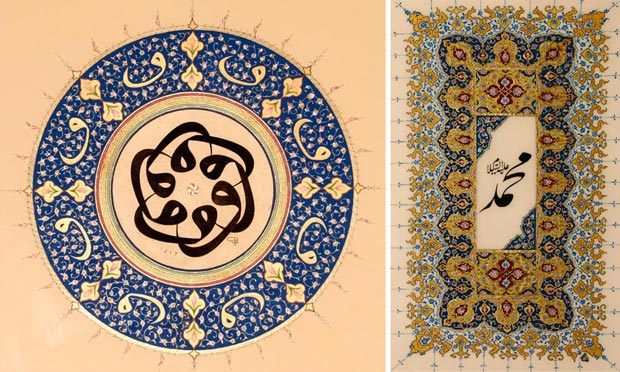 Calligraphy and tezhip artworks from The Muscat International Festival for Arts and Crafts 2012 / Courtesy of IRCICA
Calligraphy and tezhip artworks from The Muscat International Festival for Arts and Crafts 2012 / Courtesy of IRCICA
I joined the Research Center for Islamic History, Art and Culture (IRCICA) headed by Dr. Halit Eren, the Director General of the Center, in February 1987. The Center undertakes research, publishing, documentation and other scholarly activities aimed at encouraging a better understanding of Islamic culture and civilization. Its work covers various subject areas in Islamic history from the history of science to the history of art and cultural heritage.
Thank God, I found myself in a professional area dealing with a rich heritage that reflects the various aspects of life owing to its important cultural, economic and social functions. Art also plays a role as a bridge between peoples and cultures. I fell in love with the handicrafts of the Muslim World for their main role of reflecting the cultural identity and heritage of the Member States. Craft products have contributed much and brilliantly to Islamic civilization. They still contribute a great deal through the innovative work of artists. These continue to need encouragement and motivation to develop further and learn the means to ensure their ability to compete and advance their work. Being in daily contact with artisans, craft specialists and institutions around the world and working on issues of how to develop the sector through congresses, seminars, workshops, awards competitions, exhibitions and publications gives me great joy. When you see the eyes of the artisans with that happy look, it gives you the impression that you are on the right path by serving the community in this specific area.
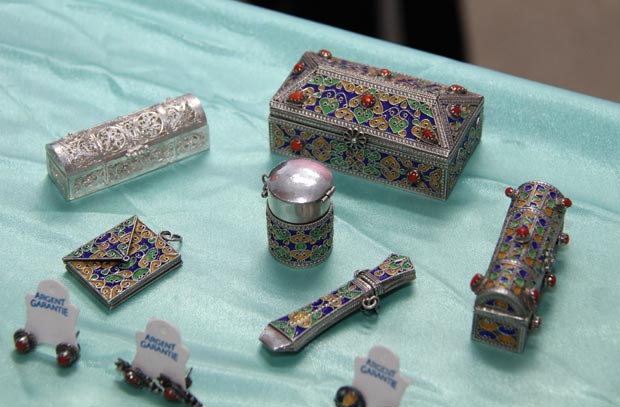 Silver work by Algerian artisan Ali Okali / Courtesy of IRCICA
Silver work by Algerian artisan Ali Okali / Courtesy of IRCICA
As a vital part of Islamic cultural heritage, crafts development and documentation was one of the fields of study to which the center gave a particular importance. We felt that the crafts sector offers excellent promises of economic revenues. It has proved to be a very rich source of foreign exchange earnings for several developing countries. Its contribution to the total foreign exchange earned from the export of manufactured items is extremely substantial in some countries and is reported among the list of major exporting items.
Besides, the crafts sector was facing difficulties that needed addressing as they were affecting its very survival. These challenges were due mainly to the increasing use of machinery, the mass production of machine-made products and the hard living conditions encouraging artisans to leave traditional work for jobs in factories. This is, of course, in addition to other factors such as the lack of funding, insufficient education and training opportunities, along with marketing difficulties. For all these reasons, we felt that we needed to develop a program that would first investigate the crafts sector through research, publications and conferences.
We have held 20 seminars to date:
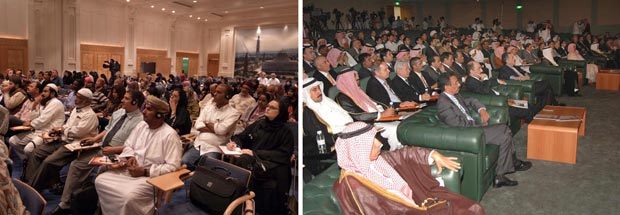 Left: Muscat Seminar on Creativity and Innovation in Crafts 2011 / Right: Riyadh Congress on Tourism and Handicrafts 2006 / Courtesy of IRCICA
Left: Muscat Seminar on Creativity and Innovation in Crafts 2011 / Right: Riyadh Congress on Tourism and Handicrafts 2006 / Courtesy of IRCICA
The first one we organized within the Crafts Development Program was “Prospects for Development of Traditional Crafts†held in Morocco in 1991. The objectives were to shed light on the splendor and wealth of the Islamic arts and crafts, evaluate the present state of traditional crafts and define future prospects and policies for their economic, social and cultural development. The seminar helped to define the weaknesses in the handicraft sector and made it possible to recognize the stresses and environmental, economic and social factors threatening its existence. We concluded that artisans were leaving their profession due to small incomes, difficulties in getting raw materials, their feeling that society’s interest in them was declining, and the struggle to find marketing opportunities. There was also an absence of any type of patronage or financial assistance programs.
These matters drew our attention to the equally vital issue of creativity which became the theme of the second seminar that set out to define a practical policy to “secure the spirit of creativity†in the arts and crafts. We organized the First International Islamic Artisans-at-Work Festival in Islamabad, which displayed the living crafts of the Islamic world, in collaboration with the Lok Virsa institute in 1994. The Festival included numerous demonstrations of artisans-at-work, folkloric parades, and musical performances. Several scholarly and artistic events also took place during the Festival period, including the International Seminar on "Creativity in Traditional Islamic Crafts", the UNESCO Experts Meeting on the Decade for Crafts Development, and the World Crafts Council Asian Assembly meeting.
The Festival was the realization of an international dream through international teamwork. 2000 artisans and delegates from nearly 73 countries - both OIC member and non-OIC member countries- participated in the events. Master artisans from OIC Member States and the SAARC, ECO and Asia-Pacific regions displayed their skills, techniques and the excellence of their work in specially designed exhibition pavilions. The festival included, besides other attractions, country pavilions of arts and crafts, an exotic craft bazaar to provide interaction between crafts, commerce and production, and provincial handicraft pavilions. Other display stalls included cultural productions, audio and video cassettes, multimedia publications and the display and sale of books on crafts. This event succeeded in creating an inter-regional awareness of the importance of craftspeople through presentation of their masterpieces and recognition of their contributions to the sector.
Over the years, we have emphasized the importance of the transmission of knowledge and the creative spirit from one generation to another. It is rewarding to see that it has been achieved when we discover that the sons of the master artisans from Egypt and Pakistan who won awards at the 1994 First International Artisans-at-Work Festival took first prizes home for themselves at the 2011 Muscat International Award for Innovation and Creativity in Crafts! I hope this gives your readers an oversight of our multi-pronged approach that focuses on artisans as much as on policy.
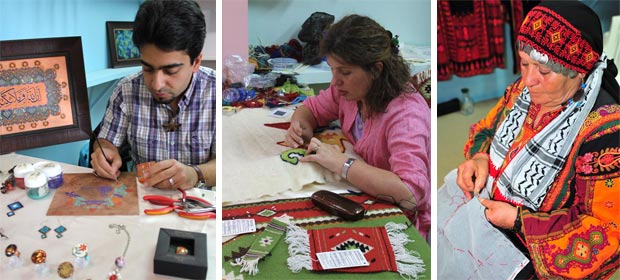 Left: Iranian artisan Kamran Arasteh working on fine-enameling / Middle: Bosnian artisan Amila Smajovic working on a Bosnian Kilim / Right: Palestinian artisan Khitam Zaki Amer Khalaf creating a traditional costume / Courtesy of IRCICA
Left: Iranian artisan Kamran Arasteh working on fine-enameling / Middle: Bosnian artisan Amila Smajovic working on a Bosnian Kilim / Right: Palestinian artisan Khitam Zaki Amer Khalaf creating a traditional costume / Courtesy of IRCICA
The other issue which we have emphasized is the issue of documenting the crafts sector. The research papers presented by experts in the field led to the establishment of a database on the present state of the crafts sector and its future prospects with the aim of developing its economic, social and educational aspects. This was compiled through the organization of various symposia that, as I mentioned earlier, addressed issues of design, skills development, quality of workmanship, economics, marketing opportunities, policy issues, programs and the standards to be implemented to control the dangers facing crafts. The deliberations of these conferences and symposia have led to a clearer understanding of the situation and resulted in many projects dedicated to promoting handicrafts and ensuring their revival.
To date, IRCICA has published ten books in the field of crafts development from the 1993 Prospects for Development of Traditional Crafts in OIC Countries to the 2012 Album of the Winning Entries of the Muscat International Award for Innovation and Creativity in Crafts published in 2012:
Our hope is that these volumes serve as primary library and reference materials for researchers and specialists working in the field of Islamic arts and crafts development and that they assist them in issues relating to design, raw materials, marketing, education, training, exchange of applied techniques, etc. We equally hope that our books are useful for academic research on contemporary handicrafts.
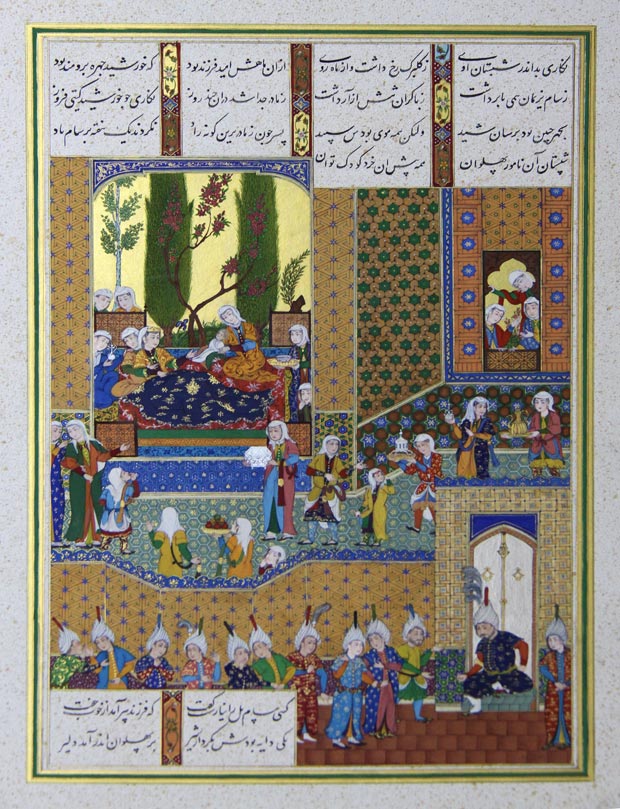 Miniature by Iranian artisan Azam Amiri / Courtesy of IRCICA
Miniature by Iranian artisan Azam Amiri / Courtesy of IRCICA
Glad to hear this question. I don’t think that modernity and its demands can stand as an obstacle against heritage development, due to the fact that our heritage does not contradict with it. Using concepts rooted in heritage to produce modern handicraft realizes the cultural and creative persistence between what it was and what it may be. In these days of global competition, we should have a clear vision and plan of how to preserve the originality of craft products and encourage their development in a way that ensures the combining of old and new into a style suitable for our era and in accordance with our needs. Generally speaking, the most important issue to be handled to secure the development of this sector is to link it with people’s daily lives. This will make crafts an indispensable living need and obviously increase demand.
Due to the fact that the cost of investment in the crafts sector is less than in other sectors, governments are happy and willing to develop it. Because the cost of purchasing tools and setting up workshops is not high, the handicraft sector could attract many sponsoring authorities once aware that it creates jobs and provides a wide range of returns. Crafts are the only sector that continues to provide employment in a time of crisis. They offer a potentially very powerful source of employment generation in countries facing abundant labor, low labor force participation and high disguised unemployment. Therefore the sector can help a lot in raising the labor force participation in these countries with very little investment. Furthermore, the financial and banking institutions, which have an interest in the issues of export credit, guarantees, trade facilitation and documentation, would find in it a new area of investment and business that would encourage artisans to develop new craft projects. Crafts are one of the rare activities providing an exceptional opportunity for economic revival and the redeployment of manpower in declining regions.
 Jewelry stand of Mali artisan Assetou Gologo / Courtesy of IRCICA
Jewelry stand of Mali artisan Assetou Gologo / Courtesy of IRCICA
I see tourism as one of the most important means of development. It provides an enormous amount of income to many countries. Tourism is the main channel for marketing handicraft products through the so-called cultural tourism and the willingness of tourist groups to obtain souvenirs from the places they visit. They mostly focus on handmade objects. One of the most effective ways to revitalize the craft sector is therefore by linking the crafts business with the tourism sector. Recent statistics show that the handicraft sector is able to attract about 20% of the tourist market in developing countries. We need to emphasize the integration of the concept of craft tourism into the plan of action for the domestic development of crafts. This can be done by encouraging different forms of promotion of tourist crafts. The statistics for tourism are very important, as shown by many studies. This proves that returns would make countries think deeply about this issue. The introducing of new craft items and the production of many varieties of craft products could have encouraging effects, which would pave the way for a real promotion.
According to statistics, Spain is visited by an average of 55 million tourists annually. It is considered that one tourist may spend US$100 during a stay, while another might spend US$5000 or even more. Let’s put forth US$1000 as the expected expenses made by every tourist. The results of our calculation suggest that the tourism sector in Spain is generating an annual income of nearly US$55 billion. Adding that the craft sector is able to attract about 20% of this tourist market, then for sure the results will be marvellous, especially when we know that a major part of the tourist groups seek to visit Andalusia and the Alhambra Palace in particular where they see many types of innovative work made by medieval artisans like arabesque decoration, calligraphy, woodwork, glass and tile work. This evidence shows that a country like Spain is employing the available craft resources in the country well.
The World Tourism Organization estimates that cultural tourism represented about 40% of international tourism in 2006, making it one of the highest growth sectors in the world. There are many states which have done well in the sector. Recent statistical data shows that 2 million artisans are working in the crafts sector in Thailand generating an annual income of US$4.55 billion. In Mexico, 6.5 million artisans are involved in this field, while it provides Colombia with an annual income of roughly US$400 million, including some US$40 million in exports. Again we see that in order to motivate manpower in a more active way that will lead to the improvement of the labor force, countries are struggling to search for opportunities. Crafts is that opportunity. It provides jobs for women as well, allowing those who stay at home to improve the living standards of their families.
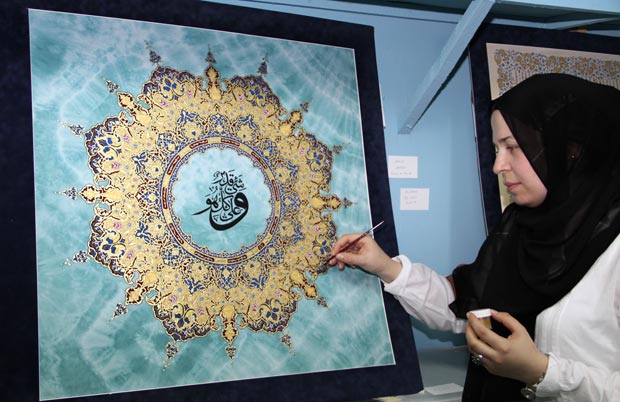 Turkish artisan Aslihan Guney / Courtesy of IRCICA
Turkish artisan Aslihan Guney / Courtesy of IRCICA
I agree that Western countries have their own agendas and national domestic programs. They effectively always seek, in their development programs aimed at non-western countries, to maintain the technological advantage in a way that will guarantee providing them with markets for their exporting products. However, I don’t agree with the idea of crafts as development dates back to the mid-20th century.
Arts and crafts have flourished throughout the ages in the palaces of sultans, kings and queens all over the world. Throughout history, the Islamic world was very rich in the field of traditional arts and crafts. Artisans and artists created magnificent works that manifest authenticity whether in the domain of miniature painting, pottery, ceramics, carpets and kilims, woodwork, metal crafts, costumes, embroidery, textiles, leather crafts, mosaic, architecture, art, decoration, architectural design, bookbinding, stucco colored glass, traditional costumes and other media as well! These works reflect perfection and beauty thanks to fundamental aesthetic rules devised by these artisans who have controlled the process of innovation until now. Workshops were made for artisans to innovate and produce masterpieces that were presented as gifts to important delegates or were sold by master artisans to traders or art lovers and collectors.
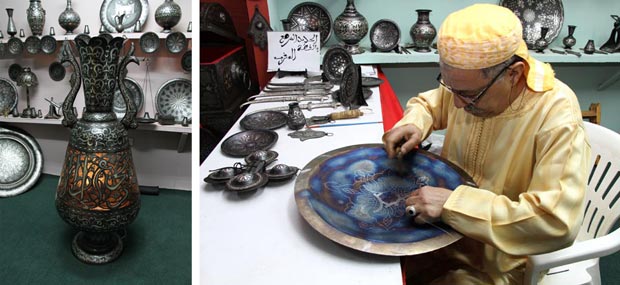 Moroccan artisan Jalil Al-Sakrouni with his 1st prize metal work at the Muscat 2012 Festival / Courtesy of IRCICA
Moroccan artisan Jalil Al-Sakrouni with his 1st prize metal work at the Muscat 2012 Festival / Courtesy of IRCICA
Economics have always been a reality of the arts industries. For example, one of the flourishing workshops that still exist in Istanbul is the Yıldız Porcelain Factory which was established by Sultan Abdul Hamid II in 1890 to meet the interior decoration needs of the Ottoman Palace. At that time there was a high demand for porcelain from both the court and the wealthy classes. As a result, large quantities of porcelain were imported from European countries at high prices. This economic consideration must have been the crucial factor in the decision to open a local factory. From 1894 onwards, in addition to vases, wall plates and other primarily decorative objects such as wash basins, writing sets, dinner, tea and coffee services, plates for visiting cards, lidded bowls, dishes, and jugs for Ashura, bonbon dishes in the form of water melons, and other items for daily use also began to be produced. The main subjects of the painted designs were portraits of the sultans, panoramas of Istanbul, figures of women and children, mythological and allegorical scenes, arabesque scrollwork, floriated patterns and rococo style country scenes. The decorators included well known painters such as Hazret-i Sehriyari, Ali Ragip, Enderuni Abdurrahman, Omer Adil, and many others. Consequently, the Imperial Porcelain Factory, whose primary purpose was to produce decorative porcelain for the palace and court circles, also played a significant role in the stylistic development of this art. Porcelain wares manufactured in the factory were decorated mainly by hand; only a minor part used industrial processes. The historical evidence on the importance of handicrafts and their influence, even in other societies, is great.
Crafts were always central to the economy of the Muslim world and I argue that they still can be. The gifted hands of artisans are still producing excellent handicraft pieces in demand sometimes even by international museums. Like the beautiful carpet commissioned by the British Museum from the DOBAG project working with handmade carpet crafts villages in Anatolia. These villages are reviving the use of botanical natural dyes. The continuous creativity of the artisans stimulates us to take care of our handicrafts and to recognize its constructive role in development. We have to study its features, know its peculiarities, determine the points of weakness preventing its advancement, and establish bases to take care of the artisans and recognize their importance in society. They are the basic factor of cultural continuity.
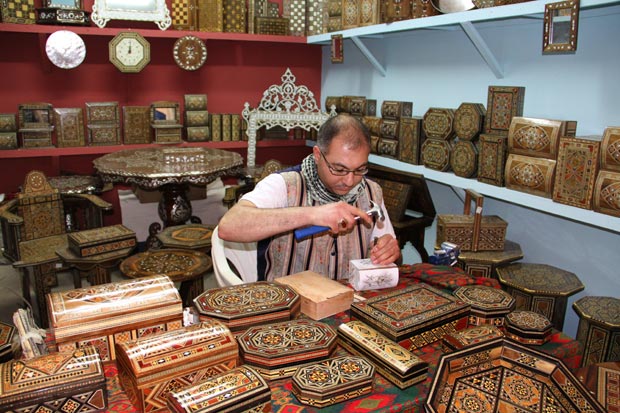 Syrian artisan Mohamed Ben Mohamed Khair creating sadaf wooden craft / Courtesy of IRCICA
Syrian artisan Mohamed Ben Mohamed Khair creating sadaf wooden craft / Courtesy of IRCICA
Despite the fact that we are aware of the development opportunities the sector is able to provide and which contribute positively to social development, we find that many people in the cultural and economic sectors still do not recognize the importance of the craft sector. That is because it has not yet received what it deserves of the now lagging revenues and profits it provides. We need to be better aware of the real contribution made by artisans to society. This will urge us to provide them with the necessary means to continue their work as they are the basic element for the endurance and continued creativity of our heritage.
The responsibility of promoting and developing the crafts sector is not limited to the artisans only. The data we have seen proves that the revenue it produces is beneficial to and covers all developing sectors in the Member States. This brings us to the question of what we have done to promote this sector. In short, evaluating what we have done in this field will reveal our negligence. We are not yet aware of its advantages and are still at the beginning of a long road that necessitates the drawing of a clear plan. We have to take certain measures to encourage the craft sector to comply with the present needs of the society and maintain its traditional originality. Without any doubt, such a progress will lead to a future increase of demand in the sector, as it is now happening in some countries. Countries like Morocco, Indonesia, Turkey, Senegal and Tunisia took pioneering steps in this field by establishing craft villages which were put on the agenda of the tourist programs.
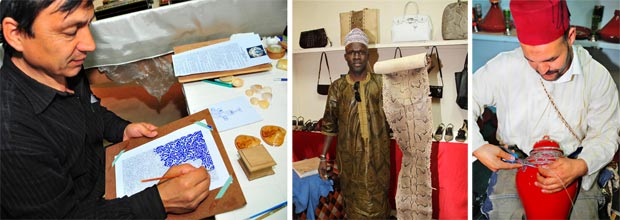 Left: Uzbek artisan Kurambay Matmuratopv making a miniature / Middle: Senegal artisan Omar Diagne Gueye with his leather crafts / Right: Moroccan artisan Oma al Masmoudi creating a silver crafts / Courtesy of IRCICA
Left: Uzbek artisan Kurambay Matmuratopv making a miniature / Middle: Senegal artisan Omar Diagne Gueye with his leather crafts / Right: Moroccan artisan Oma al Masmoudi creating a silver crafts / Courtesy of IRCICA
Yes, they are but there are others too. For example, handicrafts provide Malaysia with US$500 million of annual income. The 2012 statistics of the National Artisans Agency in Tunisia states that 350,000 artisans are working in the crafts sector and that the number of crafts institutions has reached 1200. The sector is providing around 7,000 job opportunities every year and the Tunisian craft exports reached the amount of 385 million Tunisian dinars. Craft exports are rising much faster than overall trade. Going through a recent survey on Morocco, for example, we see that more than 30% of the workforce is involved in the craft industry and that crafts production represents 19% of its GDP, including exports estimated at US$63 million. The phenomenal growth in Moroccan exports has also led to large-scale employment.
Turkish governmental bodies like the Ministry of Culture and Tourism, DOSIM, a sub-institution of the ministry and various similar associations have been trying to preserve and develop Turkish handicrafts. At present, Turkish artisans have been encouraged by the above to design products having traditional characteristics. Meanwhile, more and more pieces of modern style crafts have also been designed and produced to fit the requirements of contemporary lifestyles and tastes. There are various small-scale firms and hundreds of small workshops in the Kutahya and Istanbul regions working in the field of both traditional and modern style ceramics. Visiting these workshops is one of the most important items on the agenda of tourist tours. In addition, the country has a great jewelry tradition where 100 tons of silver is transformed into jewelry each year. Carpets and kilims constitute the major part of Turkish craft exports though. The next largest product groups are ceramic statuettes and decorative objects, copper articles, handmade glass and marble objects and frames. Besides traditional handicrafts, giftware items such as imitation jewelry, toys, artificial flowers, stationary materials, promotional gift articles are widely produced. Every year, about 15 handicraft and giftware fairs are organized in different Turkish cities. The largest and most international is the Arts and Crafts Fair held in October in Ankara.
So many other countries are doing well some in a diverse array of Islamic crafts, others specializing in just a few. We could mention Iran, Azerbaijan, Egypt, Kazakhstan, Kyrgyzstan, Turkmenistan, Tajikistan, Uzbekistan or Pakistan. There are also advanced activities to promote the sector in countries like Saudi Arabia, Indonesia, Algeria, Lebanon, Burkina Faso and Senegal for craft villages.
If we consider Islamic art as a glorious present from Islamic culture to human culture, we see that crafts are in fact its actual translation. They are an expression of beauty that has tried and is still trying to contribute various images of creativity that lead to the enrichment of the Islamic cultural heritage.
Today we are witnessing a high degree of understanding of the real value and importance of the sector for OIC member countries from the angles of culture, heritage, economy and tourism. We are also witnessing, now and then, many activities such as fairs, lectures, symposia, and congresses dealing with different aspects of the sector. These activities are accompanied with good marketing opportunities for artisans’ products along with plenty of restoration projects for traditional buildings. They are encouraged by a stronger feeling of the importance of the sector which, embodying a particular cultural identity, demonstrates its artistic, economic, social and touristic richness.
 Left: Uzbek artisan Nilufar Musadjanova making a silk handmade embroidery / Right: Algerian artisan Lallali Mounira making an illumination with silver / Courtesy of IRCICA
Left: Uzbek artisan Nilufar Musadjanova making a silk handmade embroidery / Right: Algerian artisan Lallali Mounira making an illumination with silver / Courtesy of IRCICA
Well, I do find myself in the crafts sector and I have been interacting now for more than 25 year with artisans and following the promotional steps and progress they have made in their applied techniques. Learning about the use of natural materials and natural dying as friendly elements to our environment, in addition to seeing the innovative designs, rich attractive colors and fantastic final touches have undoubtedly attracted me to collect some wonderful products made by artisans whose level of excellence resulting from a long period of continuous invention I am proud of. Among the works I have collected are silk carpets from Iran and Egypt with some kilims and carpets from Turkey, Turkmenistan and Azerbaijan, miniature paintings from Uzbekistan, a handmade vase made of camel leather from Pakistan, handmade pottery and ornamented silver from Algeria, some calligraphy plates, some pottery pieces from Indonesia. There is also batik cloth from Malaysia and Brunei Darussalam, a few pieces of traditional costumes from Palestine and Malaysia, silver craft products from Tunisia and Syria, glass plates from Lebanon and a piece of pottery from Venezuela.
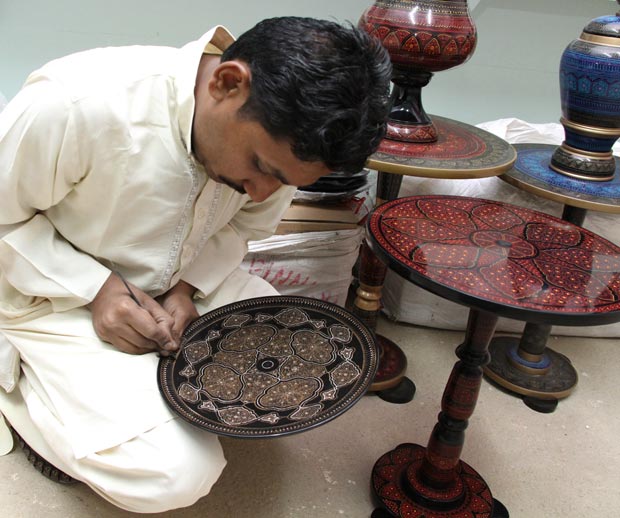 Pakistani artisan Muhmmad Naeem Shahzad making lacquer crafts / Courtesy of IRCICA
Pakistani artisan Muhmmad Naeem Shahzad making lacquer crafts / Courtesy of IRCICA
This year we were lucky to have successfully organized alhamdulillah the second session of the Muscat International Festival for Arts and Crafts which was convened in early March 2012. The festival was jointly organized by the Muscat Municipality of the Sultanate of Oman and the Research Center for Islamic History, Art and Culture (IRCICA), Istanbul. Alongside the festival we also organized the "Muscat International Award for Innovation and Creativity in the Crafts" with prizes worth US$150,000 and the International Exhibition of Artisans-at-Work. The jury committee consisted of craft experts with years of experience in the area of handicraft development. The entry tickets show that there were one and a half million visitors.
Exhibition participants and visitors enjoyed the opportunity to meet artisans from 32 various countries, inquire about their work, or even acquire some craft works. The event therefore provided a unique opportunity for raising public awareness of crafts. The craft bazaar was organized in the form of a craft village where craft products from different countries were displayed for sale. Visitors and tourist groups enjoyed the facility of discovering the diversity of handicrafts such as sewing and embroidery, traditional costumes, carpets and rugs, decorating, Qur’an binding and gilding, marbled paper, architecture, mashrabiyya, stucco colored glass, pottery and ceramics, silver and metal crafts, and engraving. We also organized a folklore show where groups from Oman, Kazakhstan, Dagestan, Palestine and other countries performed.
 The Muscat International Festival for Arts and Crafts 2012 / Courtesy of IRCICA
The Muscat International Festival for Arts and Crafts 2012 / Courtesy of IRCICA
We are in the process of organizing the "Tehran International Congress on the Features, Characteristics and Cultural and Economic Contribution of Arts and Handicrafts†that will be accompanied by an exhibition of albums, catalogues and books published in the field of arts and handicrafts. The event is organized by IRCICA and the Organization for Culture and Islamic Relations of Iran and will take place this year from May 5 to May 9. The congress aims, among other things, to explore the means to optimize the use of the craft sector in the areas of culture and tourism and the benefits for tourism when it is linked with arts, heritage and handicrafts. The meeting will also underline the need to preserve the authenticity of these traditional skills and to promote them by myriad available means.
I would like to thank you too for taking this duty of responsibility to address the issue of artisans and crafts development within the media with the aim of raising more awareness of the real importance of arts and crafts. It is critical that we better understand the real contribution made by artisans and the sector itself to the economies of our societies as well as the set of opportunities crafts provide for expressing cultural identity in a way that encourages dialogue among nations.
Comments
Add a comment